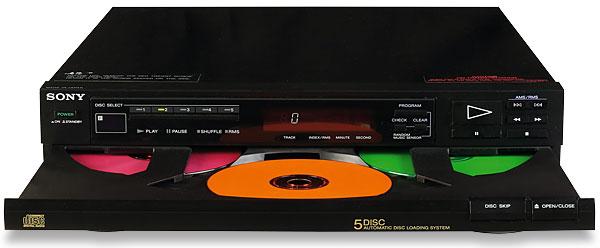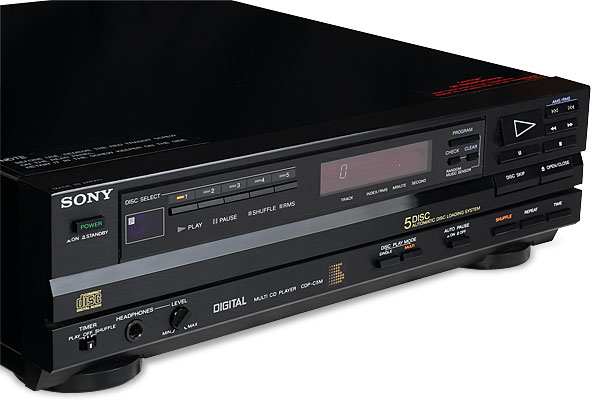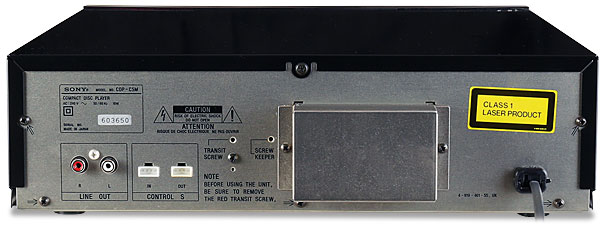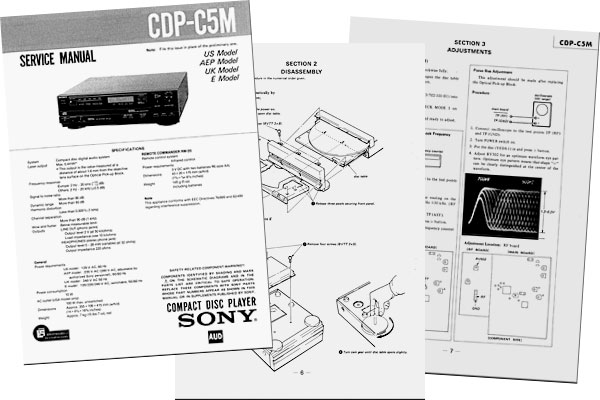Sony CDP-C5M CD player

 We hear a midi-sized multi-CD player from 1987 boasting a digital filter on board, but does multi-play convenience mean there's a penalty to pay in terms of sound?
We hear a midi-sized multi-CD player from 1987 boasting a digital filter on board, but does multi-play convenience mean there's a penalty to pay in terms of sound?
The word 'autochanger' strikes fear into the hearts of LP listeners, bringing thoughts of clanking levers, heavyweight arms and stacks of records slamming on top of each other. The situation is more favourable when it comes to CD. Most players handle discs mechanically anyway, and so only a relatively straightforward extension to the mechanism is needed to allow more than one disc to be loaded at a time.
What's more, every CD player requires a microprocessor of some sort to control the complex business of retrieving the data from the disc and turning it back into an audio signal. This can easily be expanded to control disc changing too. The result is simple and foolproof operation.
Life is a Carousel
The Sony CDP-C5M represents one type of multi-CD player: the carousel type. Discs are loaded onto a turntable (for want of a better word) that presents them one at a time to a conventional optical unit, which in this case is located at the back of the machine. Size constraints limit the number of discs this type of player can take to five or six, although the ingenious refinement introduced in later models of holding the discs vertically rather than horizontally expanded it to a hundred or more.

The alternative, as championed by Pioneer, was to house the discs in a cartridge. The advantage was that the user could buy multiple cartridges and share them between home and in-car players, provided they were of the same make, as there was never anything approaching an industry standard. The disadvantage was that the players tended to be more mechanically complex and more expensive.
Sony was not the first company to bring a multi-CD player to market in the UK, that honour going to Toshiba with its twin-tray XRV-22 of late 1985. The Sony CDP-C5M appeared in 1987, by which time the design and construction of the basic parts of a CD player had become sufficiently routine for the extra ones required for multi-play operation to be added without the finished machine being unreasonably expensive. The 'M' suffix refers to the width of the fascia, at 355mm or 'midi' size. Just a few months later the CDP-C5F appeared, the 'F' standing for full width (430mm).

Over The Wall
Internally the two models were identical, an empty extension box being screwed to the side of the CDP-C5M chassis to fill the space inside the larger cabinet. Despite starting out with carousel players, Sony also made cartridge models in the years that followed. Sharing the ten-disc XA-10B cartridge with its early in-car changers, the CDP-C100 of 1988 also featured a Philips TDA1541A dual-DAC chip with fourfold oversampling to befit its large size and status as an upmarket machine.
The CDP-C5M also demonstrated the gradual improvements that were being made in digital audio technology. Oversampling and digital filters were at last appearing in Japanese players after years of reliance on 'brick wall' analogue filtering in the final stages of the circuit. The digital filter used in the CDP-C5M was still a simple twofold oversampling affair and a single time-shared DAC (a Burr-Brown PCM56P in this case) was retained. But the oversampling did at least halve the phase error between the two channels inherent in the single-DAC method and eased the design problems associated with brickwall filters.
Sony used the word 'Unilinear' to describe its new CD technologies, but the word was applied indiscriminately across a range of widely differing models, robbing it of any real meaning. Despite being an up-to-the-minute design at the time, 16-bit/2x single-DAC players were only really a feature of the 1986 and 1987 seasons. By 1988 twin DACs and fourfold oversampling were the norm.

Load And Store
The machine's disc-changing mechanics were straightforward, adding only two extra motors to the three that CD players of this era normally have. The carousel slid out on a power-operated drawer so that discs could be loaded one by one, their presence being detected automatically so one could load as many as one liked. Interaction with other Sony units was possible via the Control S standard connection, multi-CD players being a natural addition to an automated system. For the less ambitious, the RM-D5 infrared remote control unit (included as standard) allowed armchair operation of the commonly used functions.
Operating the CDP-C5M is only slightly more involved than using a single-play machine of the same era. Discs are loaded one at a time in the position presented in the centre of the tray, which can be incremented round by pressing the 'Disc Skip' key. Playback starts with the last disc loaded, or whichever one is selected using the five direct-access keys by the display.
Each of these 'Disc Select' keys has a coloured light. If it is red this indicates that a disc is present in the corresponding slot, green means that a disc is playing or will be in the front slot when the carousel is opened, while orange denotes that the player has just discovered there is no disc in the slot that is ready to be played next.

Loading is reasonably rapid if you load the discs strategically, but annoyingly slow if you don't. The carousel only rotates clockwise, so stepping backwards (eg, disc four to disc three) involves almost a complete lumbering rotation. The discs are read quickly once they are clamped into the optical deck, they can just take a while to get there!
Single Play
The shuffle play option turned out to be a disappointment. Random selections are only made from one disc, and not until every track has been played (albeit in a random order) is the next one chosen. Random play between discs would have been more entertaining. Still, one can also use the CDP-C5M as a single-play machine which speeds up the loading process. Pressing the 'Single' button sees the disc from the frontmost loading position (whichever that may be) played directly and the discs in the other slots on the carousel not checked. Used in this manner, the Sony CDP-C5M almost feels like a traditional CD player.


















































